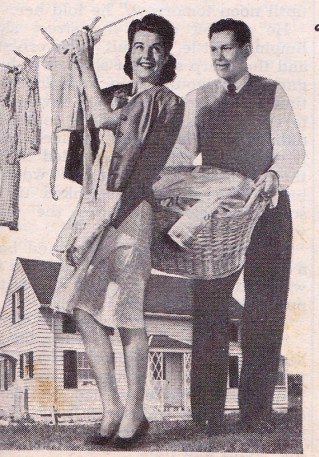 Hooray for springtime — a season of carefree clothes-drying in the Ozarks. I actually dry clothes outside all year, but by mid-March no longer have to worry about sleet covering the wash. And what a winter it has been. Many times, I made a 50-yard dash to snatch the laundry ahead of another snow storm.
Hooray for springtime — a season of carefree clothes-drying in the Ozarks. I actually dry clothes outside all year, but by mid-March no longer have to worry about sleet covering the wash. And what a winter it has been. Many times, I made a 50-yard dash to snatch the laundry ahead of another snow storm.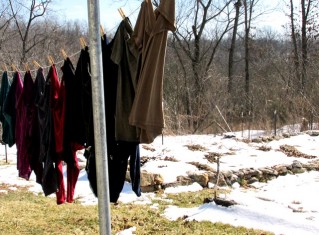
I’ve been meaning for some time to write about the benefits of drying clothes outdoors, but thought addressing how to do so was too elementary, like instructing how to wash dishes by hand. Then, I noticed Google searches that led people to our site, such as “how to dry clothes outdoors the old-fashioned way.”
That did it. I had to join the nationwide movement to bring back clotheslines. There are even organizations devoted to not only encouraging outdoor drying, but to helping persuade municipalities and homeowner associations to allow residents to put up clotheslines. How did it get to this, you ask?
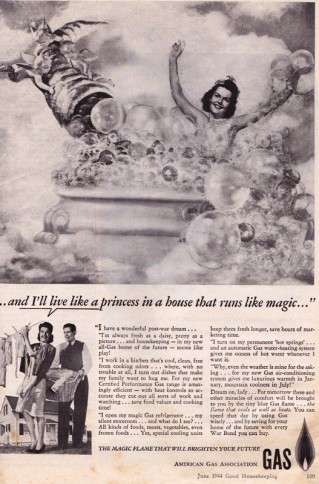 This June 1944 Good Housekeeping ad shows a smiling housewife dreaming about the end of the war so they will be able to buy appliances again (manufacturers would making only war supplies). She is so taking down laundry because she knows when victory finally comes, her husband will buy her a gas dryer. And so the advertisements went for many decades after, prompting us to live like queens with appliances to tackle all our household labor. To have a clothesline eventually became a symbol of poverty.
This June 1944 Good Housekeeping ad shows a smiling housewife dreaming about the end of the war so they will be able to buy appliances again (manufacturers would making only war supplies). She is so taking down laundry because she knows when victory finally comes, her husband will buy her a gas dryer. And so the advertisements went for many decades after, prompting us to live like queens with appliances to tackle all our household labor. To have a clothesline eventually became a symbol of poverty.
So, here we are 70 years later with folks trying to figure out how to hang clothes out to dry. Fortunately, there is nothing difficult or mysterious about it – and the benefits are many. Clothing smells fresher, costs nothing to dry and lasts longer. You get exercise, fresh air and an overall good feeling outdoors. It also consumes roughly the same amount of time to hang and take down clothing if you fold it as you go, as it does to unload a dryer and fold the clothes.
The percentage of American households with clothes dryers is more than any other country, about twice as many as European homes, for example. But, our numbers are coming down as more people view dryers as an unnecessary luxury. Perhaps the economy changed their opinion. Whatever the reason, this is encouraging news.
While in Walmart earlier this winter, I wandered over to the housewares section to compare the price and quality of mass-produced clothespin bags to my treadle-sewn Granny’s Clothespin Bags. When I couldn’t find any, I asked a store clerk, a woman of about 65. She said the store did not carry them anymore and that she even had customers ask her what a clothespin bag is.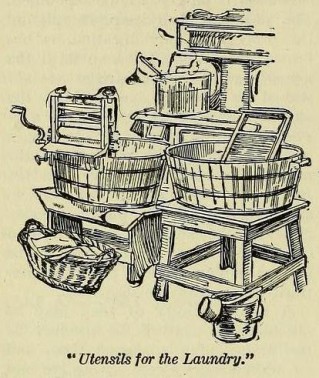
The most expensive part of line drying is the posts, which can vary vastly in price and materials. Ours is made of welded steel posts, but salvaged lumber would work as well. Build it well, and you will not ever have to replace it. Mine is positioned in partial shade so I can hang colored items out of direct sunshine.
Cotton line is better than plastic for gripping clothes. It does not last as many years as plastic, but is still inexpensive and readily available.
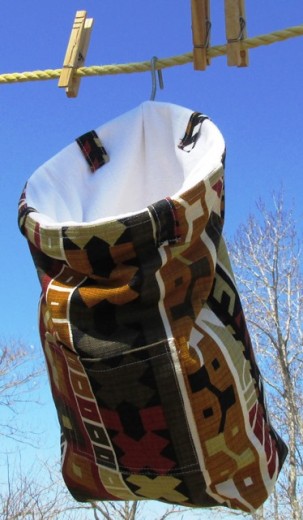 As with any tool, such as clothespins and bags, you want reliable products that make the task easier and more enjoyable. Anyone who line dries clothes can understand the frustration of seeing a freshly-washed blanket in a heap below the clothesline because the pins didn’t hold in the wind. Or when hanging wet, heavy jeans, the first clothespin snaps and goes sailing before the second one can be clipped on the line.
As with any tool, such as clothespins and bags, you want reliable products that make the task easier and more enjoyable. Anyone who line dries clothes can understand the frustration of seeing a freshly-washed blanket in a heap below the clothesline because the pins didn’t hold in the wind. Or when hanging wet, heavy jeans, the first clothespin snaps and goes sailing before the second one can be clipped on the line.
If you haven’t yet heard of Classic American Clothespins, please see their site. Each one is handcrafted of quality ash wood and stainless steel springs to last a lifetime. They truly make the dollar store variety look like toys.
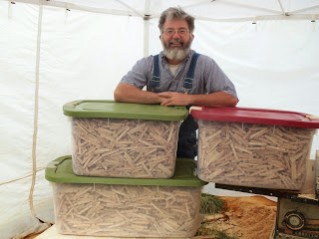 Another frustration-saver is a sturdy clothespin bag or apron. I make both, but prefer the bag because it is easy to slide on the line and quickly grabbed ahead of surprise rain showers. It also is convenient for storing clothespins in a closet or on a hook in the laundry room or porch. Customer Herrick Kimball, the clothespin craftsman, hangs his from his belt like a tool bag.
Another frustration-saver is a sturdy clothespin bag or apron. I make both, but prefer the bag because it is easy to slide on the line and quickly grabbed ahead of surprise rain showers. It also is convenient for storing clothespins in a closet or on a hook in the laundry room or porch. Customer Herrick Kimball, the clothespin craftsman, hangs his from his belt like a tool bag.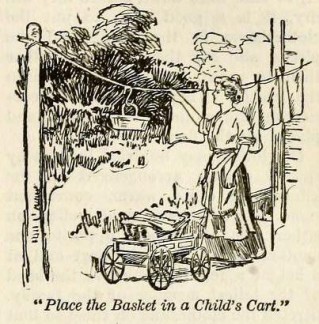
I do not know of an alternative yet to plastic clothesbaskets, but am always on the lookout for the wicker kind we had when I was a child. In the meantime, plastic works fine. It just annoys me.
There are a host of very informative sites with details about the art of line drying, so I won’t go into them here. If you’d like to know how they dried clothes in 1909, read my blog, or read a free pdf version of the Household Discoveries book on Open Library.org. The Wash Day chapter begins on page 355.
©2014 Well WaterBoy Products LLC ♦ WaterBuck Pump™ ♦ Pedal Powered PTO™ 








